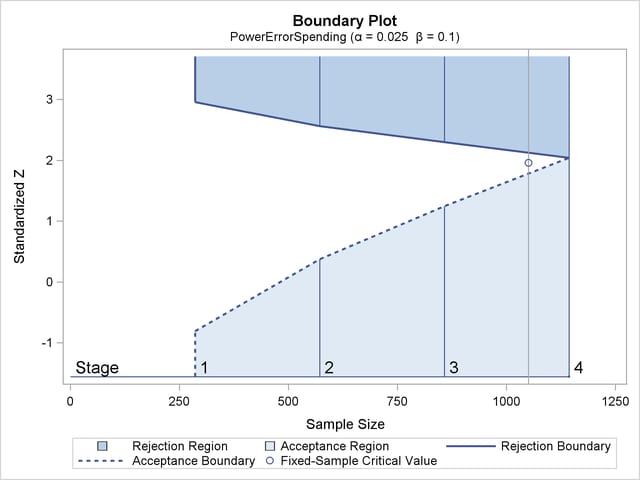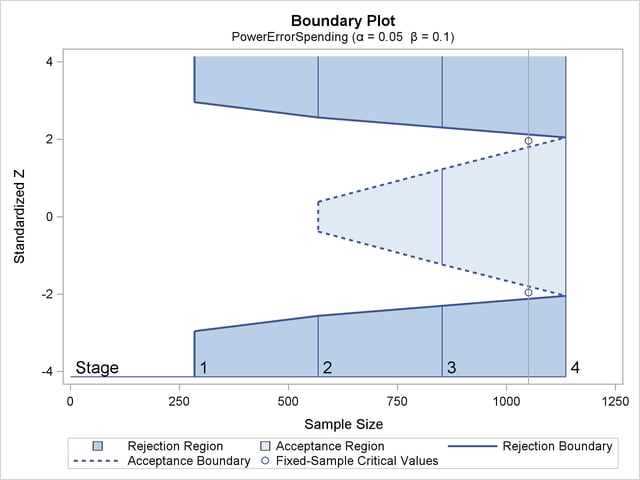| The SEQDESIGN Procedure |
| Boundary Variables |
The boundaries created in group sequential trials depend on the type of the alternative hypothesis and the early stopping criterion. Table 78.5 shows the boundaries created with various design specifications.
Specifications |
Boundary Variables |
||||
Alternative |
Lower |
Upper |
|||
Hypothesis |
Early Stopping |
Alpha |
Beta |
Beta |
Alpha |
Lower |
Accept |
X |
|||
Reject |
X |
||||
Accept/Reject |
X |
X |
|||
Upper |
Accept |
X |
|||
Reject |
X |
||||
Accept/Reject |
X |
X |
|||
Two-sided |
Accept |
X |
X |
||
Reject |
X |
X |
|||
Accept/Reject |
X |
X |
X |
X |
|
Up to four boundaries can be generated in a group sequential design:
the upper
 boundary, to reject the null hypothesis for the upper alternative
boundary, to reject the null hypothesis for the upper alternative the upper
 boundary, to accept the null hypothesis with an upper alternative
boundary, to accept the null hypothesis with an upper alternative the lower
 boundary, to accept the null hypothesis with a lower alternative
boundary, to accept the null hypothesis with a lower alternative the lower
 boundary, to reject the null hypothesis for the lower alternative
boundary, to reject the null hypothesis for the lower alternative
For a two-sided design, the null hypothesis is accepted only if both the hypothesis is accepted with an upper alternative and the hypothesis is accepted with a lower alternative.
For a one-sided design with a lower alternative, only the lower boundaries are created. Similarly, for a one-sided design with an upper alternative, only the upper boundaries are created. For example, Figure 78.10 shows the boundary plot for a one-sided test with an upper alternative.

Figure 78.10 corresponds to a one-sided sequential design with early stopping to reject or accept the null hypothesis. For a sequential test with early stopping only to reject the null hypothesis, there are no acceptance boundary values at interim stages. The acceptance boundary value and its associated acceptance region are displayed only at the final stage. Similarly, for a sequential test with early stopping only to accept the null hypothesis, there are no rejection boundary values at interim stages. The rejection boundary value and its associated rejection region are displayed only at the final stage.
For a two-sided design, both the lower and upper boundaries are created. For a design with early stopping to reject the null hypothesis,  boundaries are created. Similarly, for a design with early stopping to accept the null hypothesis,
boundaries are created. Similarly, for a design with early stopping to accept the null hypothesis,  boundaries are created. For a design with early stopping to accept or reject the null hypothesis, both the
boundaries are created. For a design with early stopping to accept or reject the null hypothesis, both the  and
and  boundaries are created.
boundaries are created.
For example, Figure 78.11 shows the boundary plot for a two-sided test.

Figure 78.11 corresponds to a two-sided sequential design with early stopping to reject or accept the null hypothesis. For a sequential test with early stopping only to reject the null hypothesis, there are no acceptance boundary values at interim stages. The acceptance boundary value and its associated acceptance region are displayed only at the final stage. Similarly, for a sequential test with early stopping only to accept the null hypothesis, there are no rejection boundary values at interim stages. The rejection boundary value and its associated rejection region are displayed only at the final stage.
Copyright © SAS Institute, Inc. All Rights Reserved.
